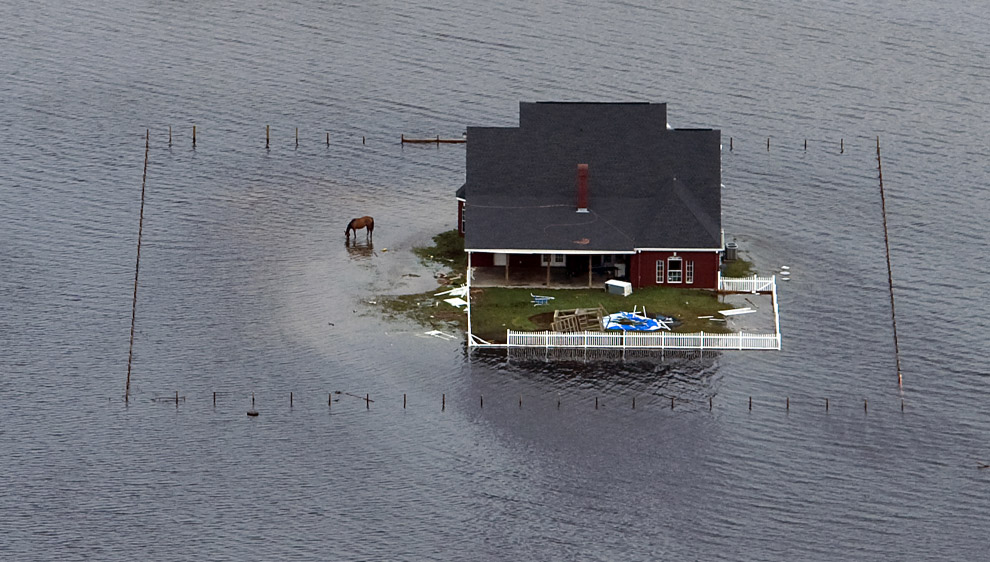Staying or Leaving in the Face of a Disaster Becomes a Critical Consideration for Horse Owners


Barrett Slenning, an associate professor in the NC State College of Veterinary Medicine’s Department of Population Health and Pathobiology, is an expert in epidemiology and animal biosecurity risk management.
My previous blog referenced general preparedness issues relating to horses and disasters and finished with a discussion of a common horse-specific disaster: barn fires. In this post, we’ll look at longer term disasters where a horse owner must be prepared to shelter in place or evacuate on a moments’ notice.
[section_subtitle] Sheltering in place [/section_subtitle]
Staying put means you and your animals will be limited in your movements for days, at the least, under conditions where infrastructure support may be lacking. You should plan on being self-sufficient for at least 96 hours.
While some North Carolina owners keep horses on their property, the majority house their animals at commercial or cooperative stables. If you use such a facility, find out if the operator has an emergency plan and if that plan has ever been exercised. It’s possible that the individuals who support that stable may be unable to do so during a prolonged disaster. This means you are going to be short-handed, just as the workload goes way up. Plan for it.
If your barn is on a well, losing power means losing water. Having a gas or diesel generator with the capacity to power your well, a few lights, a power tool, and part of your electric fence—if you have one—will ease your workload and worry. Be sure to maintain the generator and have easily accessible directions so anyone can connect it to the barn’s electrical supply.
Sheltering in place requires feed and water for the immediate disaster. A 900 to 1,000-pound horse will drink six to 10 gallons of water a day. A four-day supply for one horse, then, is some 24 to 40 gallons of water.
Feed is easier to stockpile. Two to three bales of your regular hay should cover the minimum 96-period. However, if you don’t want to depend on the feed store being open immediately after the disaster, you’ll need to have more hay on hand. If you regularly run low on hay, reconsider how you purchase feed to ensure you have enough.

[section_subtitle] Evacuation planning [/section_subtitle]
If the disaster is such that you cannot stay on site—the barn burned, there’s a chemical spill, or a tornado or hurricane made the barn unstable—you need to be prepared to relocate your horse. Here are seven things to consider.
[section_subtitle] Here are seven things to consider. [/section_subtitle]
- Timely decision making. A critical element in an evacuation is making the decision in time, especially when dealing with the logistics of transporting 1,000-pound animals. Owners who take too long to decide may become trapped in traffic or find themselves sheltering in a potentially dangerous environment. Think now how and when you’ll make the call to go.
- Handling your rig. Many horses are injured in transportation accidents due to lack of driver experience with a big load. There are stories of horses and owners being injured or killed in western wild fires because the owner could not back up a truck and trailer; someone else had always transported the horse. Learn how to handle your own rig.
- Maintaining trailer and tow vehicle. Many horse owners have trailers but too often the trailer or the tow vehicle is not in good shape. Owners may have an older truck or SUV as the tow vehicle and only use it for that occasional purpose. As a result, it might spend weeks or months without being driven and may not be dependable when it is needed most. Keep your vehicle and trailer clean, supplied, and maintained, because a disaster will not wait for you to get ready. Especially important: maintain trailer tire inflation pressure, brake function, lights and other electronics, and lubrication.
- Practice loading and unloading. Know you can load your horse into a trailer quickly, efficiently, and safely under a variety of situations. I can’t tell you how many times I’ve seen owners at our Equine and Farm Animal Veterinary Center spend an extended time trying to get a balky horse to load. Such a delay during a disaster ca
 n be deadly to you and your horse. Be sure you can load your horse at night and in poor weather. Practice it. Do it regularly, too.
n be deadly to you and your horse. Be sure you can load your horse at night and in poor weather. Practice it. Do it regularly, too. - Prioritize which horses go first. Another problem occurs when you face evacuating multiple horses and limited trailer space. If you have several horses, take the time now to prioritize which horse will be helped first, which one next, and so on. You may be able to hand lead horses out in an emergency, but experts strongly recommend against it: Leading a group of frightened horses under bad conditions down a road filled with emergency vehicles and panicked people in cars has too many ways to go wrong. These are difficult decisions. It may help to do this with family and friends to gain their support for your decisions.
- Know ahead of time where you’ll be going. Surveys suggest that more than a third of horse owners do not know where to take their horse in an emergency. During a disaster many owners will be looking for places for their horses, so you should have two if not more options planned ahead of time. In a major disaster, relocation centers will be set up at fairgrounds, race tracks, and other areas. Find out now what the plans are for your part of the state and keep maps accessible to show best and alternate routes to these areas. If you don’t know where to start, contact your county Cooperative Extension office. For North Carolina horse owners, the NC Department of Agriculture link at the end of this post provides a list of relocation resources. Wherever you plan to go, contact the sites at least annually and confirm those options.
- Have records and equipment in hand. Lastly, be sure to have photographs and records showing your proof of ownership, vaccination history of the horse, and a current negative Coggins test. Most relocation sites will not allow you entry without such documentation. Bring along your own feed, tack, manure rakes, buckets, brushes, and other equipment so you can properly maintain your own horse while away from home.
I cannot tell you under what conditions you should shelter in place or evacuate. Now is the time to set the criteria you will use to make those personal decisions.
If you shelter in place, be sure your barn is going to be habitable and stocked for at least four days. If you are to evacuate make sure your vehicle and trailer are in good repair, that you know three or more places you could go, and that your horse(s) can be loaded quickly and safely under less than ideal situations.
There will always be disasters. We cannot prepare for every contingency but if you are ready for things common to most emergencies, you will have gone a long way to mitigating the damage and pain such events may bring.
There is more to being ready than what we’ve touched on in the last two blogs. A few sources for more information on your horse and disasters:

NC Department of Agriculture and Consumer Services
NC State University College of Veterinary Medicine


